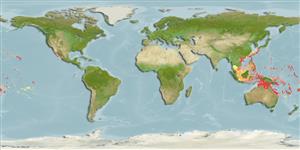Teleostei (teleosts) >
Perciformes/Uranoscopoidei (Sand dwellers) >
Pinguipedidae (Sandperches)
Etymology: Parapercis: Greek, para = the side of + Greek, perke = perch (Ref. 45335); australis: Named for its southern distribution, south of 14° south latitude.
More on author: Randall.
Environment: milieu / climate zone / depth range / distribution range
Ecology
Marine; demersal; depth range 1 - 82 m (Ref. 86942). Tropical; 1°N - 38°S, 129°E - 172°W
Western Central Pacific: Queensland, Australia (Ref. 54621) and Tonga (Ref. 53797).
Size / Weight / Age
Maturity: Lm ? range ? - ? cm
Max length : 9.2 cm SL male/unsexed; (Ref. 57562)
Short description
Identification keys | Morphology | Morphometrics
Dorsal spines (total): 5; Dorsal soft rays (total): 20 - 21; Anal spines: 1; Anal soft rays: 17. D V,20-21 (rarely 20); A I,17; 14-16 (rarely 14 or 16) pectoral rays; 48-59 lateral-line scales; 3-4 + 6-8 gill rakers; 5-6 predorsal scales; ctenoid scales on cheek; front of lower jaw with 10 canine teeth; vomerine teeth in a broad chevron pattern; with palatine teeth; upper edge of subopercle with a prominent sharp spine; posterior edge of preopercle sometimes slightly irregular or partially finally serrate; body depth 4.35-4.9 in SL (20.5-23.0% SL); middle dorsal spine longest, 9.5-10.6% SL; membrane from last dorsal spine joined to base of first soft ray; slightly rounded caudal fin, 22.9-24.0% SL; color pattern essentially similar to Parapercis cylindrica except that the caudal fin is not yellow (Ref. 57562).
Type specimen collected from a depth of 3 m (Ref. 53797).
Life cycle and mating behavior
Maturity | Reproduction | Spawning | Eggs | Fecundity | Larvae
Randall, J.E., 2003. Review of the sandperches of the Parapercis cylindrica complex (Perciformes: Pinguipedidae), with description of two new species from the western Pacific. Bishop Museum Occasional Papers (72):1-19. (Ref. 57562)
IUCN Red List Status (Ref. 130435: Version 2024-1)
Threat to humans
Harmless
Human uses
Fisheries: of no interest
Tools
Special reports
Download XML
Internet sources
Estimates based on models
Preferred temperature (Ref.
123201): 24.3 - 27.9, mean 26.3 °C (based on 158 cells).
Phylogenetic diversity index (Ref.
82804): PD
50 = 0.5000 [Uniqueness, from 0.5 = low to 2.0 = high].
Bayesian length-weight: a=0.00692 (0.00314 - 0.01524), b=3.06 (2.88 - 3.24), in cm total length, based on LWR estimates for this Genus-body shape (Ref.
93245).
Trophic level (Ref.
69278): 3.4 ±0.4 se; based on size and trophs of closest relatives
Resilience (Ref.
120179): High, minimum population doubling time less than 15 months (Preliminary K or Fecundity.).
Fishing Vulnerability (Ref.
59153): Low vulnerability (10 of 100).
Nutrients (Ref.
124155): Calcium = 397 [235, 787] mg/100g; Iron = 1.57 [0.95, 2.65] mg/100g; Protein = 17.2 [14.9, 19.0] %; Omega3 = 0.192 [0.101, 0.362] g/100g; Selenium = 51.2 [24.6, 106.3] μg/100g; VitaminA = 32.9 [11.3, 90.7] μg/100g; Zinc = 1.93 [1.34, 2.73] mg/100g (wet weight);
